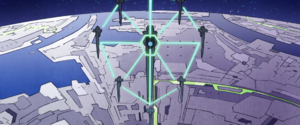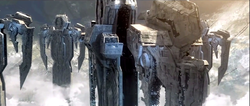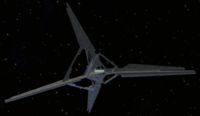Forerunner fleet
From Halopedia, the Halo wiki

The Forerunner ecumene operated a vast fleet of military starships responsible for space warfare. Most Forerunner fleets were historically operated by the Warrior-Servants, until their diminishing by the Builders, which saw many of their fleets transferred under Builder Security. The ecumene's collective naval force was led by Forerunner Fleet Command.[1][2]
History[edit]

Throughout Forerunner history, from their ancient civil wars to the human-Forerunner wars and later the Forerunner-Flood war, a great number of deciding battles were fought between naval fleets. It is evident that the total Forerunner fleet consisted of millions of ships, given the numbers of the losses suffered during the war and the fact that a single AI would take personal command of a core fleet alone of one thousand ships, combined with the three million worlds that the Forerunners controlled. However, this number was severely whittled down over three centuries of war. During the course of the war, Forerunner fleets attempted to prevent the Flood from landing on the surface of various planets, and when the Flood invariably did, the fleets' main concern was to evacuate as many civilians as possible.[1] At a certain point during the war, the Forerunners drew their final defensive line at the protected boundary of the Orion complex — the Maginot Sphere — leaving all systems beyond the line to fend for themselves. However, this was not a permanent solution, as the Sphere and its Line installations had failed in the past.[3]
The Forerunners had created a master AI, Mendicant Bias, to coordinate all of their strategic movements against the Flood. However, Mendicant Bias defected to the Flood after direct contact with the Gravemind, and began to actively work towards its creators' destruction. More setbacks followed with the Flood growing in numbers and power, forming compound intelligences of enormous power called Key Minds.[4] By this point, the Forerunners had resorted to more extreme means to control and contain the Flood, burning entire star systems by initiating premature supernovas.[1] Although formidable, the Forerunners' fleets proved virtually helpless against the new tactics adopted by the Flood in the later years of their conflict: through the logic plague, the parasite was able to rapidly corrupt the ancillas on which the Forerunners were heavily reliant. In addition, Forerunner weapons and countermeasures provided little defense against the powerful suppression fields generated by Precursor star roads and other neural physics artifacts, which could disable the Forerunner ships' weapons and shields as well as prevent them from accessing slipspace, making them easy prey to the Flood.[5]
As the Forerunners realized that they had no chance of militarily winning the war, they eventually resorted to the firing of the Halo Array, their ultimate last resort which would cleanse the galaxy of all sentient life. The Flood and Mendicant Bias realized this, and led their fleet of over five million ships to the Maginot Sphere to access the lesser Ark directly and stop the firing of the Halos. However, the IsoDidact, overall commander of the remaining Forerunner military, had dispatched Offensive Bias, a loyal AI commanding the remains of the Forerunner fleets, to meet Mendicant's fleet at the Maginot Sphere. During the ensuing battle, the IsoDidact fired the Halo Array, which neutralized Mendicant Bias's giant Flood-controlled fleet, which had until this point, vastly outnumbered Offensive Bias. With the odds much more even, Offensive Bias managed to defeat the rampant AI's remaining core ships and delivered Mendicant Bias to the Ark for study.[1]
Without any Forerunners to guide them, some Forerunner ships crashed onto various objects and were later found by the races of the Covenant, some utilizing the ships' advanced technology. For example, the Forerunner Dreadnought was used to power the Covenant capital of High Charity.[6]
Technology and capabilities[edit]

Forerunner vessels were extremely powerful and well protected. Like the ships of most navies, Forerunner vessels ran the gamut from small and maneuverable to enormous, although the scale of the latter was far beyond anything that came since: Mantle's Approach, the Didact's 371-kilometer-long personal command ship, was noted as not being the largest of its kind.[7] However, even ships this large could be equipped with cloaking measures.[8] The numbers of vessels utilized in battle were also overwhelming, with capital warships, such as Fortress-class vessels, supported by potentially millions of automated support craft,[9] along with dedicated fleets of sentinels.[10] As with the rest of Forerunner society, artificial intelligence constructs—ancillas—performed a range of roles in naval fleets, supplementing their biological masters. metarch-class ancillas could, in an emergency, replace Forerunner commanders,[11] and the most powerful class of metarch, Contender, could control millions of ships at once.[1] Cyberwarfare also had an important role in fleet engagements; enemy vessels could be targeted with AI suppressors capable of disabling their control ancillas and, in certain cases, even the crew.[12]
The Forerunners' extensive understanding of Slipstream space and related technologies pertaining to the utilization of its extended range of dimensions were also evident in their space warfare doctrine. Unlike the younger civilizations, which are almost invariably constrained to the framework of conventional spacetime, the Forerunners waged battles across hyperdimensional complexes—branes—accounting for vectors of eleven-dimensional slipspace transit while using constantly adjusting scalars in an effort to measure potential outcomes as a given battle progressed.[13] This was partly made possible by the Warrior-Servants' powerful mental capabilities, which also allowed them to experience a battle in multiple variable time streams, while sharing sensory input with other Warriors.[14] A singular Forerunner fleet engagement could potentially occur in coordination across multiple star systems and involve hundreds of thousands of warships.[15] The Forerunners were also able to weaponize reconciliation—the adjustment of space-time to mend causal infractions caused by superluminal travel—hampering with and in some cases entirely denying their enemies' the ability to travel in slipspace.[16]
While the Forerunners could effectively commence direct planetary bombardment via their energy weapons, a peculiar Forerunner weapon used during planetary assaults would cut off and lift up an enormous portion of the planet's crust, overturn it, and drop it back down.[17] Single-occupant attack vehicles—some of them classified as forms of battle armor, like war sphinxes or seekers—could be deployed in swarms across continents and had the ability to destroy entire cities.[18] As a more extreme measure, the Forerunners were also capable of artificially inducing premature stellar collapses in the event the Flood overran a star system.[1] To combat the Flood, the Forerunners equipped their starships with a mechanism known as Modular Dispersal Technology, a means to efficiently scuttle sections lost to the Flood while maintaining the integrity of the rest of the ship. This technology was later appropriated for use by the Covenant.[19]
As with the rest of their technology, Forerunner ships were superior to those of the modern civilizations in most respects. A single Keyship could power High Charity, a structure the size of an entire moon,[20] by using less than a tenth of its total power output.[6] In a UNSC naval assault against the Covenant in the Battle of Voi, three UNSC frigates fired their Magnetic Accelerator Cannons at the Forerunner Dreadnought, in addition to a massive salvo of missiles by numerous Longswords, but it remained completely intact, sustaining no visible damage.[21] This makes it even more powerful than a some of the most powerful Covenant ships, which could only barely take the impact of three special light MAC rounds and five hundred Archer missiles.
Forerunners could also create upgrade seeds to upgrade vessels of other species into seamless hybrids of their original technology and Forerunner technology. This was done in cases where Forerunners encountered other races with more rudimentary ship technology, but resources would not support using a design seed to create a vessel of Forerunner design. The inclusion of a Forerunner slipspace flake would give the vessel a Forerunner slipspace drive. Other known upgrades include stealth capability, upgraded weapons, comm and navigational systems kept within the framework of the ship's original operating functional capability.[22]
Known ship types[edit]
The Forerunners categorized warships by a series of "orders". Ships would be assigned in these categories based on their role, size, or both. In a derelict Forerunner war fleet found by the Audacity in Path Kethona, capital ships approximately five kilometers in length were classified as first-order ships; accompanying four-hundred-meter-long vessels—speculated by the Librarian to be interdictors or logistical support craft—were classified as sixth- or seventh-order ships.[23]
| |||||||||||||||||||||||||||||
Known commanders[edit]
- IsoDidact
- Bitterness-of-the-Vanquished
- Examiner
- Faber
- Falchion
- Tactician
- Mendicant Bias
- Offensive Bias
Known units[edit]
Gallery[edit]
The Forerunner Dreadnought in flight.
List of appearances[edit]
- Halo 2 (First appearance)
- Halo 3
- Halo 4
- Halo Wars
- Halo Legends
- Halo: Cryptum
- Halo: Primordium
- Halo: Silentium
- Halo: Escalation
- Halo 2: Anniversary
- Halo Mythos
- Halo: Fractures
- Promises to Keep
- Untitled story (Mentioned only)
- Halo: Epitaph
Sources[edit]
- ^ a b c d e f Halo 3, Terminals
- ^ Halo: Silentium, page 197
- ^ Halo: Silentium, pages 104-105
- ^ Halo: Silentium, pages 186-187
- ^ Halo: Silentium, pages 214-215
- ^ a b Halo: Contact Harvest
- ^ Halo 4: The Essential Visual Guide, page 193
- ^ Halo: Silentium, page 273
- ^ Halo: Cryptum, page 174
- ^ Halo: Silentium, pages 261-262
- ^ Halo: Cryptum, page 256
- ^ Halo: Cryptum, page 204
- ^ Halo: Silentium, page 211
- ^ Halo: Cryptum, pages 162, 316
- ^ Halo: Silentium, page 212
- ^ Halo: Primordium, page 240
- ^ Halo: Cryptum, page 197
- ^ Halo: Cryptum, page 95
- ^ Halo Waypoint: Modular Dispersal Technology
- ^ Halo 2, campaign level High Charity
- ^ Halo 3, campaign level The Storm
- ^ Halo: Renegades, pg. ??
- ^ Halo: Silentium, pg. 120
| ||||||||||||||




